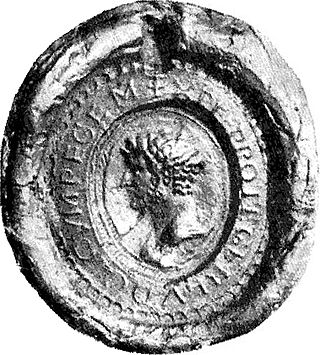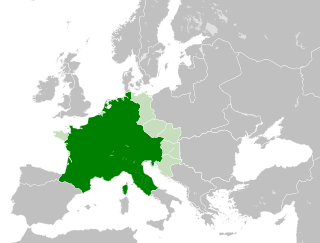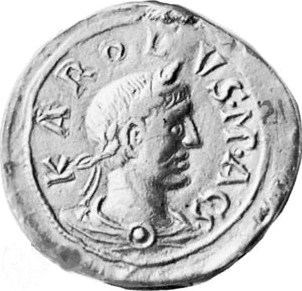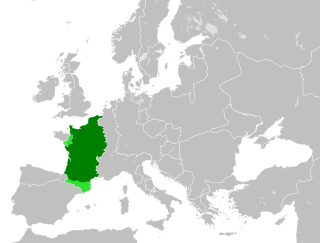
Arnulf of Carinthia was the duke of Carinthia who overthrew his uncle Emperor Charles the Fat to become the Carolingian king of East Francia from 887, the disputed king of Italy from 894, and the disputed emperor from February 22, 896, until his death at Ratisbon, Bavaria.

Louis the German, also known as Louis II of Germany, was the first king of East Francia, and ruled from 843 to 876 AD. Grandson of emperor Charlemagne and the third son of Louis the Pious, emperor of Francia, and his first wife, Ermengarde of Hesbaye, he received the appellation Germanicus shortly after his death, when East Francia became known as the kingdom of Germany.

The Carolingian Empire (800–887) was a Frankish-dominated empire in Western and Central Europe during the Early Middle Ages. It was ruled by the Carolingian dynasty, which had ruled as kings of the Franks since 751 and as kings of the Lombards in Italy from 774. In 800, the Frankish king Charlemagne was crowned emperor in Rome by Pope Leo III in an effort to transfer the Roman Empire from the Byzantine Empire to Western Europe. The Carolingian Empire is sometimes considered the first phase in the history of the Holy Roman Empire.

The Carolingian dynasty was a Frankish noble family named after Charles Martel and his grandson Charlemagne, descendants of the Arnulfing and Pippinid clans of the 7th century AD. The dynasty consolidated its power in the 8th century, eventually making the offices of mayor of the palace and dux et princeps Francorum hereditary, and becoming the de facto rulers of the Franks as the real powers behind the Merovingian throne. In 751 the Merovingian dynasty which had ruled the Franks was overthrown with the consent of the Papacy and the aristocracy, and Pepin the Short, son of Martel, was crowned King of the Franks. The Carolingian dynasty reached its peak in 800 with the crowning of Charlemagne as the first Emperor of the Romans in the West in over three centuries. Nearly every monarch of France from Charlemagne's son Louis the Pious till the penultimate monarch of France Louis Philippe have been his descendants. His death in 814 began an extended period of fragmentation of the Carolingian Empire and decline that would eventually lead to the evolution of the Kingdom of France and the Holy Roman Empire.

Charles III, also known as Charles the Fat, was the emperor of the Carolingian Empire from 881 to 887. A member of the Carolingian dynasty, Charles was the youngest son of Louis the German and Hemma, and a great-grandson of Charlemagne. He was the last Carolingian emperor of legitimate birth and the last to rule a united kingdom of the Franks.

East Francia or the Kingdom of the East Franks was a successor state of Charlemagne's empire ruled by the Carolingian dynasty until 911. It was created through the Treaty of Verdun (843) which divided the former empire into three kingdoms.

The Royal Frankish Annals, also called the Annales Laurissenses maiores, are a series of annals composed in Latin in the Carolingian Francia, recording year-by-year the state of the monarchy from 741 to 829. Their authorship is unknown, though Wilhelm von Giesebrecht suggested that Arno of Salzburg was the author of an early section surviving in the copy at Lorsch Abbey. The Annals are believed to have been composed in successive sections by different authors, and then compiled.

In medieval historiography, West Francia or the Kingdom of the West Franks constitutes the initial stage of the Kingdom of France and extends from the year 843, from the Treaty of Verdun, to 987, the beginning of the Capetian dynasty. It was created from the division of the Carolingian Empire following the death of Louis the Pious, with its neighbor East Francia eventually evolving into the Kingdom of Germany.
Harald 'Klak' Halfdansson was a king in Jutland around 812–814 and again from 819–827.
Annales Bertiniani are late Carolingian, Frankish annals that were found in the Abbey of Saint Bertin, Saint-Omer, France, after which they are named. Their account is taken to cover the period 830-82, thus continuing the Royal Frankish Annals (741–829), from which, however, it has circulated independently in only one manuscript. They are available in the Monumenta Germaniæ Historica and in a later French edition taking into account a newly discovered manuscript . The Annals of St. Bertin are one of the principal sources of ninth-century Francia, and are particularly well-informed on events in the West Frankish sphere of Charles the Bald. The Annales Fuldenses are usually read as an East Frankish counterpart to their narrative.
Henry was the leading military commander of the last years of the Carolingian Empire. He was commander-in-chief under Kings Louis the Younger and Charles the Fat. His early career was mostly restricted to East Francia, his homeland, but after Charles inherited West Francia in 884 he was increasingly active there. During his time, raids by the Vikings peaked in Francia. The sources describe at least eight separate campaigns waged by Henry against the Vikings, most of them successful.
Bernard or Bernhard was the only child of Emperor Charles the Fat. He was born of an unknown concubine and was thus considered illegitimate. Charles tried to make him his heir, but failed in two attempts.

The March of Carinthia was a frontier district (march) of the Carolingian Empire created in 889. Before it was a march, it had been a principality or duchy ruled by native-born Slavic princes at first independently and then under Bavarian and subsequently Frankish suzerainty. The realm was divided into counties which, after the succession of the Carinthian duke to the East Frankish throne, were united in the hands of a single authority. When the march of Carinthia was raised into a Duchy in 976, a new Carinthian march was created. It became the later March of Styria.
The Reichsannalen are a class of annals composed anonymously in the Carolingian Empire throughout the 9th century. They first appeared under Pepin the Short in 741 and became ubiquitous at monasteries throughout the empire in the following decades. They were not official court annals, but they often bear the bias of having been written in one regnum or another.
The Stellinga or Stellingabund was a movement of Saxon frilingi (freemen) and lazzi (freedmen) between 841 and 843. These were the middle two Saxon castes, below the nobility and above the unfree. The aim of the Stellinga was to recover those rights the two castes had possessed before their conversion from Germanic paganism in the 770s. At that time they had still possessed political privileges, but Charlemagne, having won over to his cause the Saxon nobility, had reduced them to mere peasants. The Stellinga thus despised the Lex Saxonum, which had been codified by Charlemagne, preferring to live in accordance with ancient and unwritten tribal custom. The movement was violently resisted by the uppermost caste, the nobiles (nobility), not always with the support of the Frankish kings.
The siege of Asselt was a Frankish siege of the Viking camp at Ascloha (Asselt) in the Meuse valley in the year 882. Though the Vikings were not forced by arms to abandon their camp, they were compelled to come to terms whereby their leader, Godfrid, was converted to Christianity.

Prudentius was bishop of Troyes, a chronicler and an opponent of Hincmar of Reims in the controversy on predestination.
Rodulf Haraldsson, sometimes Rudolf, from Old Norse Hróðulfr, was a Viking leader who raided the British Isles, West Francia, Frisia, and Lotharingia in the 860s and 870s. He was a son of Harald the Younger and thus a nephew of Rorik of Dorestad, and a relative of both Harald Klak and Godfrid Haraldsson, but he was "the black sheep of the family". He was baptised, but under what circumstances is unknown. His career is obscure, but similar accounts are found in the three major series of Reichsannalen from the period: the Annales Bertiniani from West Francia, the Annales Fuldenses from East Francia, and the Annales Xantenses from Middle Francia. He died in an unsuccessful attempt to impose a danegeld on the locals of the Ostergo.

Louis the Younger, sometimes called Louis the Saxon or Louis III, was the second eldest of the three sons of Louis the German and Hemma. He succeeded his father as the King of Eastern Francia on 28 August 876 and his elder brother Carloman as King of Bavaria from 879 to 882. He died in 882 and was succeeded in all his territories, which encompassed most of East Francia, by his younger brother, Charles the Fat, already king of Italy and emperor.
Bjørn was a Viking chieftain. He is the earliest known Scandinavian who was not a relative of the Danish kings to enter the service of a Frankish king, in his case Charles the Bald, king of West Francia. He may be identified with the Swedish king Björn Ironside.










